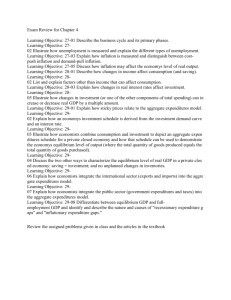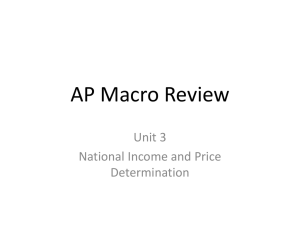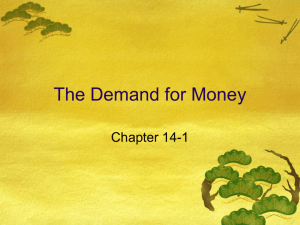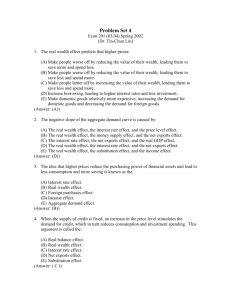File
advertisement
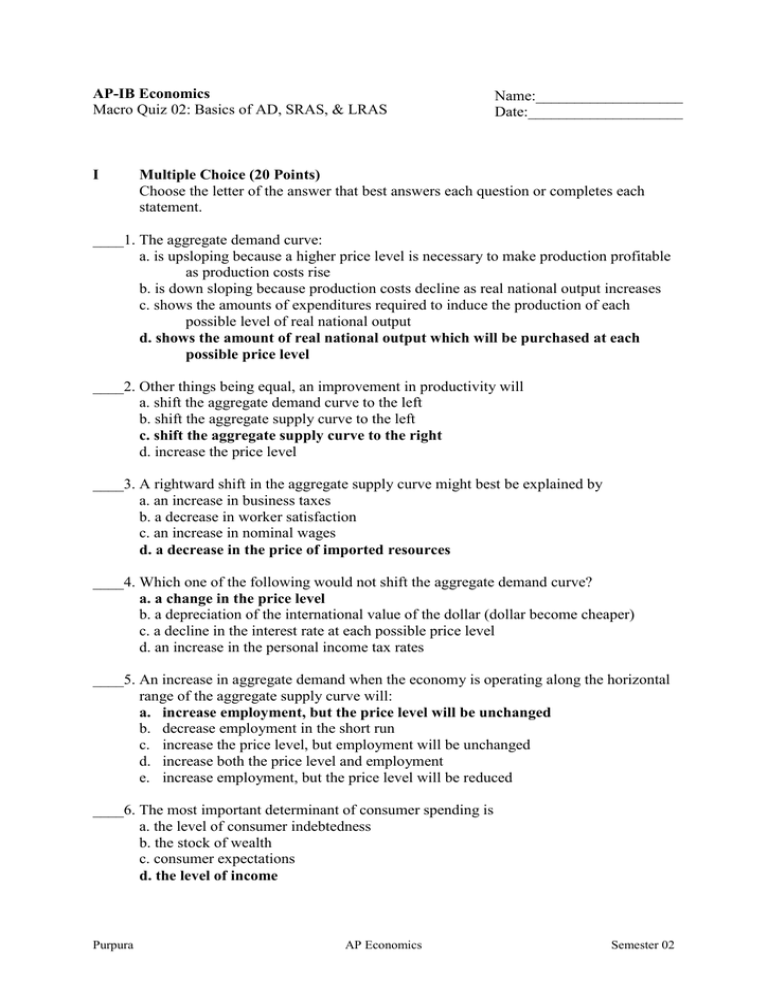
AP-IB Economics Macro Quiz 02: Basics of AD, SRAS, & LRAS I Name:___________________ Date:____________________ Multiple Choice (20 Points) Choose the letter of the answer that best answers each question or completes each statement. ____1. The aggregate demand curve: a. is upsloping because a higher price level is necessary to make production profitable as production costs rise b. is down sloping because production costs decline as real national output increases c. shows the amounts of expenditures required to induce the production of each possible level of real national output d. shows the amount of real national output which will be purchased at each possible price level ____2. Other things being equal, an improvement in productivity will a. shift the aggregate demand curve to the left b. shift the aggregate supply curve to the left c. shift the aggregate supply curve to the right d. increase the price level ____3. A rightward shift in the aggregate supply curve might best be explained by a. an increase in business taxes b. a decrease in worker satisfaction c. an increase in nominal wages d. a decrease in the price of imported resources ____4. Which one of the following would not shift the aggregate demand curve? a. a change in the price level b. a depreciation of the international value of the dollar (dollar become cheaper) c. a decline in the interest rate at each possible price level d. an increase in the personal income tax rates ____5. An increase in aggregate demand when the economy is operating along the horizontal range of the aggregate supply curve will: a. increase employment, but the price level will be unchanged b. decrease employment in the short run c. increase the price level, but employment will be unchanged d. increase both the price level and employment e. increase employment, but the price level will be reduced ____6. The most important determinant of consumer spending is a. the level of consumer indebtedness b. the stock of wealth c. consumer expectations d. the level of income Purpura AP Economics Semester 02 ____7. According to the Keynesian model, dis-savings occurs where: a. income exceeds consumption b. saving exceeds income c. savings exceeds consumption d. consumption exceeds savings e. consumption exceeds income ____8. The investment-demand curve suggests a. that the amount invested will not be affected by changes in the real interest rate b. an inverse relationship between the real rate of interest and the level of investment spending. c. that an increase in business taxes will tend to stimulate investment spending d. a direct relationship between the real rate of interest and the level of investment spending. ____9. The investment-demand curve will shift to the right as the result of a. the availability of excess productive capacity b. an increase in business taxes c. businesses becoming more optimistic with respect to future business conditions d. an increase in the real interest rate e. a decrease in the real interest rate ____10. The immediate determinants of investment spending are the a. expected rate of net profit on capital goods and the real interest rate b. level of saving and the real interest rate c. marginal propensity to consume and the real interest rate d. marginal propensity to save and the level of spare capacity in the national economy ___11. The multiplier effect means that: a. consumption is typically several times as large as saving b. a small change in consumption demand can precipitate a much larger increase in investment c. a small increase in investment can cause national income to change by a larger amount d. a small decline in the MPC can cause equilibrium national income to rise by several times that amount. e. the APC is greater than 1 ____12. A $1 Billion increase in investment will cause a: a. (1 /MPS)x 1 billion increase in equilibrium GDP b. (MPS) x 1 billion increase in equilibrium GDP c. (1—MPC) x 1 billion increase in equilibrium GDP d. (MPC-MPS )x 1 billion increase in equilibrium GDP Purpura AP Economics Semester 02 ____13. An “inflationary gap” can best be described as the amount by which: a. current national output exceeds “potential full-employment real GDP” b. planned aggregate expenditures is less than any given level of national output c. saving exceeds investment at the full-employment level of real GDP d. there is a gap between the SRAS and AD curves e. none of the above ____14. A “recessionary gap” can best be described as: a. the amount by which the full-employment GDP exceeds the level of aggregate expenditures b. the amount by which the equilibrium GDP falls short of the full-employment GDP c. the amount by which investment exceeds savings at the full-employment GDP d. the amount by which aggregate expenditures exceed the full-employment level of national output e. a decrease in nominal GDP ____15. If an increase in aggregate demand results in NO increase in real GDP, we can surmise that the: a. economy is in deep depression b. MPC is equal to 1 c. economy is already operating at full employment d. price level has fallen e. aggregate expenditures must exceed the national output ____16. The multiplier is useful in determining the a. full-employment unemployment rate b. level of unintended investment or disinvestment c. rate of inflation d. change in equilibrium GDP that will result from a change in spending. ____17. If the Federal government attempts to eliminate a budget deficit during a depression, these efforts will probably: a. shift the investment-demand curve to the right b. intensify the depression c. contribute to cost-push inflation d. alleviate the depression ____18. If government adhered strictly to an annually balance budget, then the government’s budget would a. vary in a countercyclical way b. tend to destabilize the economy c. have no impact on GDP and employment d. tend to stabilize the economy _____ 19. An increase in aggregate supply will: a. reduce the price level and real domestic output b. reduce the price level and decrease the real domestic output c. increase the price level and decrease the real domestic output d. reduce the price level and increase the real domestic output Purpura AP Economics Semester 02 II. Free Response Assume that the economy has been operating at full-employment level of output and employment but has recently experienced a decrease in consumption spending due to a sharp decline in stock market indices that have reduced the wealth of the nation by about 18%. Consumption expenditures have decreased at all levels of income. a. Use correctly labeled aggregate demand/aggregate supply curves to show the short run effect of the drop in consumption expenditures on: (4) 1. Output 2. The price level b. Identify two fiscal policy measures that could be used to counter the effects of the initial drop in consumption spending. Explain the short run effects of each of your policies on (2) 1. Output 2. Purpura The price level AP Economics Semester 02

